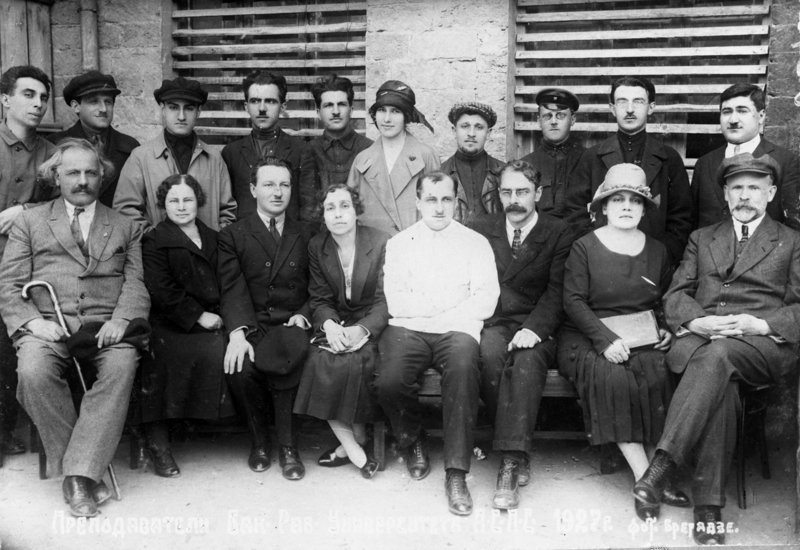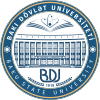After the establishment of Soviet power, the Bolsheviks, who eliminated the institutions, state symbols, and other attributes created by the Azerbaijan Democratic Republic, also began to change the content of education at the newly established University. In the early years of Soviet rule, the Bolsheviks planned to carry out a "cultural revolution" in line with their goals for building socialism. The primary task of this "cultural revolution" was to form a new Marxist-Leninist ideology in society. Education and scientific institutions were given exceptional importance in fulfilling this task.
The aspirations and hopes associated with Baku State University (BSU), created by Azerbaijan's progressive intellectuals based on national and spiritual values, were destroyed by the Soviet regime. The University fell into the grip of a completely different political system and was forced to move away from the national values and democratic principles it was built upon. Additionally, on December 6, 1922, the University's name was changed to Azerbaijan State University, and on January 23, 1924, it was named after Lenin, the leader of the Bolsheviks. Despite all the difficulties, the University carried out its mission with dignity during the years of Soviet rule. Historical developments confirmed that BSU, founded by the Azerbaijan Democratic Republic and progressive intellectuals of the time in the early 20th century, supported national and social progress even under Bolshevik ideology and became one of the sources of the Azerbaijani people's moral and cultural values. For 71 years under Soviet rule, it was the most prestigious higher education institution to which the Azerbaijani people turned for education.
Shortly after the occupation, on May 11, 1920, the first Soviet People's Commissar of EducationDadash Bunyadzade,signed a decree indicating that the University's educational and training activities would be reorganized, connections with Soviet Russia would be established, and teachers would be invited from there. During the 1920s-1930s, scholars and educators from Russia, mainly from Moscow, St. Petersburg, Kyiv, Kazan, and Odessa, were invited to the University. The first scholars to arrive during the Soviet era came from Kazan University. Gradually, a strong potential was formed in various fields of science.
Starting from 1921, efforts were intensified to prepare academic staff at the University, and defense councils, which still function today, were established.
The ideological and political orientation, scientific activities, and educational work of the University were built according to the interests of the "worker-peasant government" created by the Bolsheviks rather than the Azerbaijani people. This was based on principles of class struggle and party loyalty. During this process, some University intellectuals who opposed Soviet ideology were forced into exile, while others continued to work due to the Bolsheviks' acute need for local educated cadres in the initial period. At the same time, pressure on the University increased, and ideological "purges" were conducted. Many intellectuals became victims of mass repressions in the 1930s. The main goal of these measures was to train the new generation and qualified cadres of the Republic in the spirit of Soviet ideology.
In the first decade, the main trend was the restriction of the University's academic freedom. During this period, the University's Charter was changed four times (1920, 1922, 1923, and 1926). V. Razumovsky resigned as rector on May 26, 1920, in protest against the pressures on the University and the changes in its Charter. In November of that year, Professor Sergey Davidenkov, a graduate of Moscow University, was elected rector. However, due to the pressures, he declined to continue as rector at the end of his term in September 1923. In that year, Alexander Guliayev, a graduate of Kazan University's History and Philology Faculty and a professor at the University's History and Philology Faculty at the time, was elected rector.
In 1923, it was deemed necessary to reorganize the University, as some faculties of Azerbaijan State University and Azerbaijan Technical Institute did not meet the requirements, and their curricula were not in line with reforms. Alexander Guliayev, the new rector, approached the issue differently and prioritized the preparation of highly qualified specialists and scientific workers. The reforms began with the establishment of the Pedagogical Faculty in 1924, based on the faculties of Social Sciences and Natural Sciences, and continued with other processes. Furthermore, the University's leadership was required to submit the updated Charter for approval to the Central Committee of the Communist (Bolshevik) Party of Azerbaijan. A unified statute was prepared for all higher education institutions based on the charters of universities in the RSFSR. The "Statute on Higher Educational Institutions," approved by the Council of People's Commissars of the Azerbaijan SSR, was adopted as the University's Charter by a decision of the University Scientific Council on September 28, 1926. The University's autonomy rights were abolished. According to this Charter, the University's management was concentrated in a board of 3-5 people, and new administrative bodies for higher education in Azerbaijan, such as subject commissions, department bureaus, and dean's offices, were established.
In 1926, Taghi Shahbazi became the first Azerbaijani rector of the University. His appointment led to significant work on expanding education in the Azerbaijani (Turkish) language, opening Azerbaijani departments in faculties, and recruiting Azerbaijani teachers. Measures were also taken to increase the number of local people among students and faculty.
 |
| Taghi Shahbazi, the first Azerbaijani rector of the university (1892-1938) |
By April 1929, it was reported that 123 of the 232 professors and lecturers at the University were Azerbaijani. National composition across faculties showed that 79%ofthe staff at the Oriental Faculty, 56% at the Medical Faculty, 45% at the History and Social Sciences Department of the Pedagogical Faculty, 37% at the Natural and Mathematical Department, and 30% at the Law Faculty were Azerbaijani. This data reflected the national potential in the fields of education and science at the time. This academic staff laid the foundation for the training of national personnel and the development of many scientific fields in Turkish (Azerbaijani) until the end of the Soviet period.
 |
| A group of university teachers (1927) |
Between 1919 and 1929, approximately 1500 graduates completed their studies at the University. Of these, 1200 graduated from the Medical Faculty, and the rest from other departments. Distinguished individuals from this period includeJafar Jabbarli,Ahmad Shahmaliyev,Hadi Aliyev, Hanafi Zeynalli,, Ashraf Huseynov, Vali Khuluflu, Mammadhasan Dadashov, Feyzulla Gasimzada, Hadi Mirzazada, Sara Ashurbayli,, Alisohbat Sumbatzada, Mammad Arif Dadashzada, Iskhag Jafarzada, Jumshud Zulfugarli, Mirali Akhundov, Jafar Khandan,and others, who made significant contributions to the development of science, education, and various sectors in the republic.
|
A group of students of the Faculty of Philology of the University. 2nd from the right in the front row: Jafar Khandan Hajiyev (1930) |
Graduation of 1929/1930 of the Faculty of Medicine of the University (1930) |
1930/1931 graduation of the Faculty of Science and Mathematics of the University (1931) |
In 1929, the University’s 10th anniversary was celebrated at the national level, with a commission led by;Gazanfar MusabayovChairman of the Azerbaijan SSR People's Commissariat. Events were held in Baku, other cities, and regions of the republic. The grand celebration took place on January 12, 1930, at the current Opera and Ballet Theater, with the participation of party, Soviet, and public representatives, and official guests. In honor of the anniversary, six faculty members were awarded the title of professor, and three professors were named Honored Scholars of Science.
During this period, a series of articles were published in the press about the University, analyzing its role in fulfilling Soviet ideological requirements. The discussions about restructuring the University, reorganizing faculties, and its expansion were underway, and from April onwards, the transformation of the faculties into independent institutes was debated
Despite all the pressure, the University became a center for intellectuals who were highly respected in society, preserved their national consciousness and identity, and contributed significantly to the future of Azerbaijan. The Bolshevik leadership was deeply concerned about this and considered it a potential threat.
The closure of universities in the USSR was part of the "cultural revolution" led by the political authorities. Actions such as shortening the duration of studies and increasing the number of workers and peasants among students negatively affected the quality of education. Faculty members, who valued traditional university education, expressed open dissatisfaction with the creation of pedagogical faculties and the departure from traditional educational structures, considering it a decline in the academic level of the University.
On July 23, 1930, a decision was made by the USSR Ministry of Education and the Higher Education Committee to restructure the higher education system. The plan was to create independent specialized educational institutions capable of training the necessary number of specialists in a short period. Following the Azerbaijan SSR People’s Commissariat decision on May 9, 1930, the Medical Faculty was transformed into a Medical Institute, and on November 19, 1930, the decision was made tosu spend the University’s operations. New independent institutes were established based on its faculties, such as the Azerbaijan Medical Institute, Azerbaijan Pedagogical Institute, Soviet Construction and Law Institute, and Azerbaijan Trade and Cooperation Institute.
"Baku State University. 100 Years of Science and Education" (Baku, 2019).
This content is derived from the book





